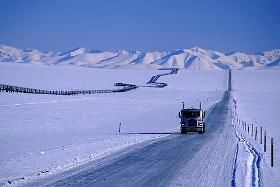CRST Petitions FMCSA For 7/3 Sleeper Berth Split
Topic 9989 | Page 1

Hold the phone.. team drivers have a different time frame on drive time, on duty time and sleep time? this is confusing to me... i don't understand those current rules or the ones being petitioned.
HOS:
Hours Of Service
HOS refers to the logbook hours of service regulations.
Hold the phone.. team drivers have a different time frame on drive time, on duty time and sleep time? this is confusing to me... i don't understand those current rules or the ones being petitioned.
team drivers have the same HOS as a solo driver. They are wanting to change that.
HOS:
Hours Of Service
HOS refers to the logbook hours of service regulations.
HAHA, sorry, not helpful on my part... But... Good luck with that CRST.

HAHA, sorry, not helpful on my part... But... Good luck with that CRST.
They're not trying to pioneer this exemption, they're only trying to get the same exemption as McKee Foods.
The request comes just a week after Overdrive reported on FMCSA’s March-made decision to allow private carrier McKee Foods’ team drivers to use 5/5, 4/6 or 3/7 split sleeper berth periods to satisfy the required 10 hour off-duty time.
Sleeper Berth:
The portion of the tractor behind the seats which acts as the "living space" for the driver. It generally contains a bed (or bunk beds), cabinets, lights, temperature control knobs, and 12 volt plugs for power.
CSA:
Compliance, Safety, Accountability (CSA)
The CSA is a Federal Motor Carrier Safety Administration (FMCSA) initiative to improve large truck and bus safety and ultimately reduce crashes, injuries, and fatalities that are related to commercial motor vehicle
FMCSA:
Federal Motor Carrier Safety Administration
The FMCSA was established within the Department of Transportation on January 1, 2000. Their primary mission is to prevent commercial motor vehicle-related fatalities and injuries.
What Does The FMCSA Do?
- Commercial Drivers' Licenses
- Data and Analysis
- Regulatory Compliance and Enforcement
- Research and Technology
- Safety Assistance
- Support and Information Sharing
Fm:
Dispatcher, Fleet Manager, Driver Manager
The primary person a driver communicates with at his/her company. A dispatcher can play many roles, depending on the company's structure. Dispatchers may assign freight, file requests for home time, relay messages between the driver and management, inform customer service of any delays, change appointment times, and report information to the load planners.OWI:
Operating While Intoxicated
I suggested a similar flexible split sleeper earlier in "+8,4+6, 5+5, etc.2I hate having to cheat". Just say in a 24 hour period, you get two big breaks totaling 10 hours, one must be 3 hours or more, and the other the balance (like 2+8, 3-1/2 + 6-1/2, 5+5, etc.
But the FMCSA just won't listen to me. I don't know why.
CSA:
Compliance, Safety, Accountability (CSA)
The CSA is a Federal Motor Carrier Safety Administration (FMCSA) initiative to improve large truck and bus safety and ultimately reduce crashes, injuries, and fatalities that are related to commercial motor vehicle
FMCSA:
Federal Motor Carrier Safety Administration
The FMCSA was established within the Department of Transportation on January 1, 2000. Their primary mission is to prevent commercial motor vehicle-related fatalities and injuries.
What Does The FMCSA Do?
- Commercial Drivers' Licenses
- Data and Analysis
- Regulatory Compliance and Enforcement
- Research and Technology
- Safety Assistance
- Support and Information Sharing
Fm:
Dispatcher, Fleet Manager, Driver Manager
The primary person a driver communicates with at his/her company. A dispatcher can play many roles, depending on the company's structure. Dispatchers may assign freight, file requests for home time, relay messages between the driver and management, inform customer service of any delays, change appointment times, and report information to the load planners.
I suggested a similar flexible split sleeper earlier in "+8,4+6, 5+5, etc.2I hate having to cheat". Just say in a 24 hour period, you get two big breaks totaling 10 hours, one must be 3 hours or more, and the other the balance (like 2+8, 3-1/2 + 6-1/2, 5+5, etc.
But the FMCSA just won't listen to me. I don't know why.
Sorry, Errol. The fact that you drive a truck excludes you from law making. No experience required takes on a whole new meaning.
(As in they require that someone have no experience driving a truck. In case my joke wasn't as smooth as it was in my head. )
CSA:
Compliance, Safety, Accountability (CSA)
The CSA is a Federal Motor Carrier Safety Administration (FMCSA) initiative to improve large truck and bus safety and ultimately reduce crashes, injuries, and fatalities that are related to commercial motor vehicle
FMCSA:
Federal Motor Carrier Safety Administration
The FMCSA was established within the Department of Transportation on January 1, 2000. Their primary mission is to prevent commercial motor vehicle-related fatalities and injuries.
What Does The FMCSA Do?
- Commercial Drivers' Licenses
- Data and Analysis
- Regulatory Compliance and Enforcement
- Research and Technology
- Safety Assistance
- Support and Information Sharing
Fm:
Dispatcher, Fleet Manager, Driver Manager
The primary person a driver communicates with at his/her company. A dispatcher can play many roles, depending on the company's structure. Dispatchers may assign freight, file requests for home time, relay messages between the driver and management, inform customer service of any delays, change appointment times, and report information to the load planners.
I work for crst and my co driver and I drive for 9 hours and with our 30 minute dot break and 30 minute pre and post trip it's time for the other driver too start... we never run out of hours
DOT:
Department Of Transportation
A department of the federal executive branch responsible for the national highways and for railroad and airline safety. It also manages Amtrak, the national railroad system, and the Coast Guard.
State and Federal DOT Officers are responsible for commercial vehicle enforcement. "The truck police" you could call them.
New Reply:
New! Check out our help videos for a better understanding of our forum features

















Preview:








 TT On Facebook
TT On Facebook
CRST petitions FMCSA for 7/3 sleeper berth split
In the building swell of hours-of-service exemption requests, CRST Expedited has now petitioned the Federal Motor Carrier Safety Administration for an exemption from the split-sleeper berth provision for its team operations.
The current hours-of-service regulations allow drivers to split 10 hours in the sleeper into two periods provided that one period is at least eight hours and the second is no less than two.
CRST Expedited is petitioning FMCSA for an exemption from the requirement and asking to be allowed to split the sleeper berth time into two periods totaling 10 hours – provided that neither period is less than three hours. That effectively would allow teams to split their sleeper berth time into a seven-hour stretch and a three-hour stint, as opposed to the required eight- and two-hour periods.
According to CRST Expedited’s exemption request, the company’s teams travel approximately 3,500 on an average week. The company also estimates that 75 percent of its drivers obtain at least 34 consecutive hours off-duty while on the road each week.
CRST Expedited says it operates 1,500 trucks on an average day with 3,000 drivers in team operations. If the petition for an exemption is granted, it would apply to those 3,000 drivers.
“CRST states that many of their team drivers are newcomers to the trucking industry. Drivers have told CRST that driving an entire 10-11 hour driving shift is too long and that they want the opportunity to switch with a partner more frequently. According to CRST, having the flexibility to switch with a partner allows each driver to take advantage of shorter time periods when they may feel fatigued. Further, splitting the SB time for both team drivers would allow each driver to obtain sleep during critical nighttime hours, which would provide more restorative sleep,” the notice of the exemption states.
In bargaining for the exemption, CRST Expedited identified countermeasures it would take to “maintain safe operations.” These include reducing driving time from 11 to 10 hours; using electronic logging devices, speed limiting trucks to 65 mph and using trucks brought into service in 2015 that are equipped with collision-avoidance technology.
FMCSA will accept comments for 30 days beginning on Thursday, Aug. 20. Comments can be submitted electronically at regulations.gov to Docket No. FMCSA-2015-0261.
Sleeper Berth:
The portion of the tractor behind the seats which acts as the "living space" for the driver. It generally contains a bed (or bunk beds), cabinets, lights, temperature control knobs, and 12 volt plugs for power.
CSA:
Compliance, Safety, Accountability (CSA)
The CSA is a Federal Motor Carrier Safety Administration (FMCSA) initiative to improve large truck and bus safety and ultimately reduce crashes, injuries, and fatalities that are related to commercial motor vehicle
FMCSA:
Federal Motor Carrier Safety Administration
The FMCSA was established within the Department of Transportation on January 1, 2000. Their primary mission is to prevent commercial motor vehicle-related fatalities and injuries.
What Does The FMCSA Do?
BMI:
Body mass index (BMI)
BMI is a formula that uses weight and height to estimate body fat. For most people, BMI provides a reasonable estimate of body fat. The BMI's biggest weakness is that it doesn't consider individual factors such as bone or muscle mass. BMI may:
It's quite common, especially for men, to fall into the "overweight" category if you happen to be stronger than average. If you're pretty strong but in good shape then pay no attention.
Dm:
Dispatcher, Fleet Manager, Driver Manager
The primary person a driver communicates with at his/her company. A dispatcher can play many roles, depending on the company's structure. Dispatchers may assign freight, file requests for home time, relay messages between the driver and management, inform customer service of any delays, change appointment times, and report information to the load planners.Fm:
Dispatcher, Fleet Manager, Driver Manager
The primary person a driver communicates with at his/her company. A dispatcher can play many roles, depending on the company's structure. Dispatchers may assign freight, file requests for home time, relay messages between the driver and management, inform customer service of any delays, change appointment times, and report information to the load planners.HOS:
Hours Of Service
HOS refers to the logbook hours of service regulations.